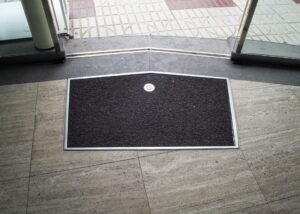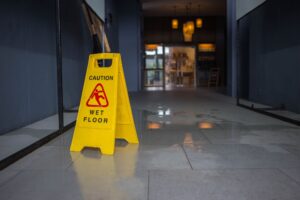An afternoon summer rain shower led to an elderly woman’s admittance to the hospital. Mrs. Jones, aged 68, entered a retail store to buy groceries for her visiting family. Mrs. Jones walked through the store’s vestibule toward the entrance where she slipped and fell, sustaining significant injuries. An investigation was conducted to determine the cause of the slip and fall incident.
The investigation revealed that the vestibule contained one mat measuring approximately 2’ by 4’. The small mat was insufficient to accommodate the heavy foot traffic and effectively absorb the rainwater tracked in by other patrons, resulting in a build-up of water on the vinyl flooring in the vestibule.
ASTM F1637-21: Standard Practice for Safe Walking Surfaces is an industry standard that provides guidance and recommendations for evaluating and improving the safety of walking surfaces to minimize the risk of slips, trips, and falls. The ASTM F1637 standard states that:
5.4.1. Mats, runners, or other means of ensuring that building entrances and interior walkways are kept dry shall be provided, as needed, during inclement weather. Replacement of mats or runners may be necessary when they become saturated.
5.4.3. Mats or runners should be provided at other wet or contaminated locations, particularly at known transitions from dry locations. Mats at building entrances also may be used to control the spread of precipitation onto floor surfaces, reducing the likelihood of the floors becoming slippery.
5.4.4. Mats shall be of sufficient design, area, and placement to control tracking of contaminants into buildings. Safe practice requires that mats be installed and maintained to avoid tracking water off the last mat onto floor surfaces.

Small mat located in the vestibule of a retail store. The mat was not large enough to adequately collect the water from patrons’ shoes as they entered the store. This allowed water to accumulate inside the vestibule on the walkway surface.
Here, the retail store failed to use a sufficient number of mats to accommodate the moisture accumulated from the heavy foot traffic of the store’s customers. The use of only one small mat did not keep the entrance of the retail store dry and as a result, the vestibule floor was a slip hazard. In addition to not providing enough mats and runners in the vestibule, the retail store failed to replace the small mat as it became saturated with rainwater in violation with ASTM F1637-21. The build-up of rainwater decreased the slip resistance of the vinyl flooring such that the wet flooring lacked sufficient traction and caused Mrs. Jones to slip and fall.
Human factors literature demonstrates that pedestrians do not typically look at their feet or the ground while walking but instead look ahead slightly below the horizon and/or towards their destination. A pedestrian’s effective visual field while walking is a cone shaped projection from the eye encompassing about 10 degrees below the horizon. Visual information that falls outside of a pedestrian’s field of view is unlikely to be noticed unless the object is made conspicuous enough to capture the pedestrian’s visual attention. Mrs. Jones was likely looking ahead to her destination of the store entrance rather than at her feet and the wet floor. She likely did not see the inconspicuous water accumulation on the floor before her fall. The vestibule did not contain any type of conspicuous warning signs to draw Mrs. Jones’ attention toward the presence of a hazardous condition.
Expectation plays an important role in a pedestrian’s ability to detect walkway hazards. Falls are more likely to occur when the condition of walkway surface contradicts with the pedestrian’s expectation of the surface. For example, if a pedestrian expects a surface to be slippery, they may modify their gait and adopt a more cautious walking gait to maintain stability. However, if a pedestrian encounters an unexpected change in walkway surface traction, a slip is more likely to occur. In this case, Mrs. Jones did not expect the vestibule walking surface to be slippery, therefore she did not adjust her gait to mitigate the slippery walkway conditions.
Neglecting to address wet conditions through proper mat placement can lead to hazardous situations and potential injuries to customers. By implementing preventive measures such as adequate matting, regular inspections and employee training, businesses can mitigate the risk of slip and fall incidents and help ensure the safety of their patrons such as Mrs. Jones.
Ellen Szubski, Ph.D., CXLT, CPSI, AHFP, is a human factors consultant at The Warren Group. She earned a Doctorate of Philosophy in Human Factors Psychology and a Master of Science in Applied Psychology from Clemson University. She did her dissertation on “The Influence of Pedestrian Biological Motion on Time-To-Collision Estimates at Night”. She is also a Certified XL Tribometrist, Certified Playground Safety Inspector and a Certified Associate Human Factors Professional (AHFP). Prior to entering the forensic field, Ellen planned and conducted experiments for a major bicycle manufacturer. She also conducted laser strike perception studies for the Department of Defense. Ellen applies her experience in Human Factors to the analysis of crash investigations and other personal injury matters. These matters often include collisions involving vulnerable road users and drivers, driver distraction, and slips, trips, and falls. She utilizes her knowledge of OSHA regulations, codes, and standards in her analysis of premises liability incidents and safety consulting. Ellen is a current member of the Human Factors and Ergonomics Society (HFES) and it’s Forensic Professional Technical Group.




